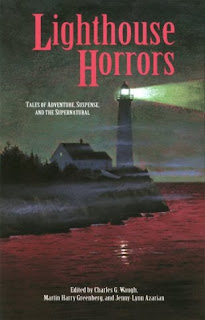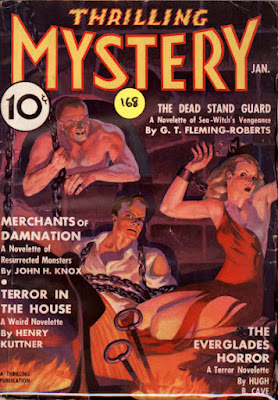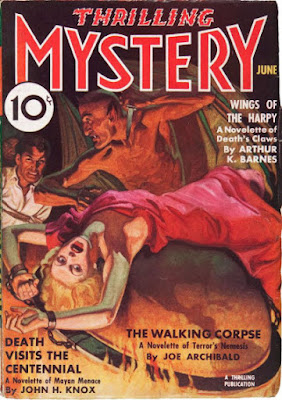Just a few days ago we read Frank Belknap Long's story from Whispers III, a 1981 anthology edited by Stuart David Schiff that published brand new stories as well as fiction and art that originally appeared in issues of Schiff's magazine, Whispers. Whispers III is full of stories by authors we have talked about in the past here at MPorcius Fiction Log; let's read three such stories, those by Ramsey Campbell, David Drake, and Hugh B. Cave. I'm reading the stories from the copy of Whispers III scanned into the internet archive, but if you collectors out there covet a physical copy of Lee Brown Coye's drawing from Whispers #9 that depicts a man cooking a baby (!) it looks like copies of Whispers III are available online for ten bucks.
"Heading Home" by Ramsey Campbell (1978)
"Heading Home" first appeared in Whispers #11-12, and, a big hit, it has since been reprinted many times, including in a 2018 anthology of horror stories called The Five Senses of Horror that includes "psychological commentary by Jessica Bayliss, PhD." Jessica Bayliss, I find, has published two YA books of fiction and is available to provide personal coaching to aspiring writers as well as to review your manuscript to make sure your characters are "super-compelling" and have "mental health diagnoses" that are "portrayed accurately.""Heading Home" is written in the rare (outside of a Fighting Fantasy Gamebook or Choose Your Own Adventure) second-person singular. I recognized the story as soon as I started reading it; I must have read it just a year or two before starting this blog, but had forgotten the title. This is a quite good story that features several of my favorite topics, like immortality, mad scientists, and disastrous sexual relationships.
As the story begins, we immediately know that "you" have been attacked by your wife's lover and incapacitated and thrown down into the basement. Campbell describes your painful climb up the stairs to the ground floor--you can hear your killers on what we yanks call the second floor, and English people like Campbell call the first floor. As you desperately ascend the stairs and then slowly crawl to your laboratory, Campbell gradually reveals that you are a scientist who has discovered how to become almost invulnerable and immortal through the exercise of conscious and precise control over your body; for example, you can detect and cure cancers within your own body by mental effort. Progress comes at a price, and in the course of your experiments you have found it necessary to murder children. The biggest reveal, which has been foreshadowed and which readers may suspect, is that your wife's lover chopped your head off, and you are just a head, struggling--successfully!--to get back to your headless body, which you will be able to reunite with.
This is a great little story that I can recommend with some enthusiasm; it deserves to be reprinted all those times and to have been psychoanalyzed by a PhD. It is especially pleasant to recommend "Heading Home" because I have so often thought Campbell's stories long and tedious and lacking a payoff commensurate with the labor required to understand them--"Heading Home" in contrast is economical (less than four pages long) and easy to figure out and has a terrific payoff.
"King Crocodile" by David Drake (1981)
"King Crocodile" is set in Ancient Egypt, I guess during or just after the military campaign that first unified Egypt under a single pharaoh, whom Drake refers to as "Nar-mer." Southerners have been marching north, conquering villages and towns as they go, and our protagonist, muscular fighting man Khati, is one of those Southerners, and has been given authority over one of those villages. The story follows Khati over several days as he interacts with the natives now under his power, and as the tale proceeds we learn about his life, personality, and relationships with the more prominent villagers.The main theme and topic of the novella (like 24 pages here) has to do with the fact that many of the villagers worship the crocodile god Sebek, but Khati hates crocodiles because a croc killed his wife, and so he encourages and even compels people to hunt and kill and eat crocodiles. A determined local priest of Sebek warns Khati to stop this blasphemy, and then a huge crocodile kills the sons of one of the richer men in the village, threatening Khati's already shaky relationship with this prominent citizen and his governorship of the whole village.
As the story title suggests, there is a struggle over who will be king to the people of the village, Nar-mer, represented by Khati, or Sebek the crocodile, who has his own representative, that priest. Drake presents us scenes in which Khati acts as a politician in competition for hearts and minds with the priest of Sebek, trying to win the populace to his side and make sure fear of the giant croc doesn't ruin the local economy, and scenes in which Khati acts as a warrior, battling it out with the monster crocodile. He faces many setbacks and dicey moments, including a good horror scene in which he is trapped in the croc's den, but in the end succeeds in defeating the reptile and its priest, though we have to wonder if Khati has lost his humanity in the process.
This is a good horror and adventure story, and it is also a story about the politics of imperialism that reminds you of accounts you hear of British rule in India and similar situations, accounts that suggest how risky it is to public order and the maintenance of imperial rule to threaten subject peoples' religions, no matter how wacky those religions may be. Editor Schiff in his little intro to the story says Drake conducted a lot of research for "King Crocodile," and there is plenty of business about the sorts of weapons people of the period carried (we learn that metal weapons are rare, for example, and that many edged weapons are made of flint or even wood) and how Nile boats were constructed back in those days; this sort of thing adds an additional layer of interest to a story that has a pulpy Conan-like climax in which Khati rescues somebody about to be sacrificed on an altar made of a fossilized giant crocodile skull.Thumbs up!
"King Crocodile" would be included in the 1989 Drake collection Vettius and Friends and in a 1992 Finnish anthology.
"The Door Below" by Hugh B. Cave
This is a long mediocre thing with an overly complicated, somewhat contrived plot, a plot sort of like that of a detective story, in which an amateurish investigator guy has a theory about some murders and finds some clues that bring the true story of the murders to his attention.Al Coppard is a middle-aged journalist. Just two weeks ago his wife filed for divorce. Don't feel bad for Al, though--he now has a hot girlfriend ten years younger than he, Wendy Corwin, his fellow reporter. Al is hoping to further his career by uncovering a scandalous conspiracy involving a rich guy and, incredibly, a young boy. You aren't supposed to like Al, I guess--the most interesting thing about "The Door Below" may be that it is some kind of attack on journalists.
As part of his pursuit of that career-making scoop, Al and Wendy paddle a boat to a lighthouse on a little half-acre island. As they explore the island and the lighthouse we are filled in on Al's conspiracy theory. In the lighthouse the journalos discover clues that explode Al's self-interested theory and indicate what really happened. Then monsters attack and Al gets killed; Wendy, perhaps, escapes.
If you are truly curious about the plot of "The Door Below," read on!
Background: The lighthouse until recently was operated by Joe Marshall, former chauffer to millionaire cosmetics manufacturer Roy Bolke. Joe got hurt in a car crash and so Roy got him the lighthouse job. Roy's wife Amanda was a kook who, like so many people in stories we read here at MPorcius Fiction Log, was a student of the occult. Amanda even wrote a book about the island the lighthouse is on, in which she put forward the theory that the island is above a gateway to hell or some other dimension full of monsters.
Joe's nine-year-old grandson Danny was with Joe on the fateful day Roy and Amanda's yacht sailed by the lighthouse. Also on the yacht was a beautiful Spanish model whom Roy was grooming to be the face of his cosmetic line. According to Danny, Joe and Roy were talking on the radio, then Roy stopped talking, so Joe and Danny took a boat out to the yacht to see if everything was OK. Everything was not OK--the Spanish model had vanished, but left her clothes on the deck, and Roy and Amanda were dead, their bodies drained of blood and covered in odd puncture wounds. Joe and Danny returned to the lighthouse, and when Danny woke up in the morning his grandfather was dead, his body in the same strange condition as Roy and Amanda's. Danny fled to shore to tell this story to the fuzz, but when the cops investigated yacht and lighthouse the bodies of Joe, Roy and Amanda had all vanished.
Al's cynical and dumb theory: Al the scandal monger thinks Danny is lying, that Joe and Roy and the Spanish model murdered Amanda and fled the country.
What really happened: Al and Wendy get stuck on the island in the lighthouse by a storm that wrecks their row boat. Al kills time by reading Amanda's book. Wendy kills time by rifling through all the contents of the light house. She finds a cassette tape recording of the radio conversation between Roy and Joe as well as a crucifix made in Spain. With these clues these two members of the Fourth Estate piece together what really happened that terrible day. Amanda cast a spell that opened that door to hell and out of it came monsters who slew her and her husband. The Spanish model survived initially because she had the crucifix. But then she disrobed to swim to shore, absent-mindedly left the crucifix with her clothes, and got killed. Danny pocketed the crucifix when he and his grandpa searched the boat. When the monsters attacked the lighthouse that night, they sucked the blood out of Joe but let tasty morsel Danny sleep on because he had the crucifix on his person.
After Wendy and Al figure this stuff out, the monsters invade the lighthouse again. Wendy has the crucifix and holds the monsters off as she runs down the stairs, leaving Al behind to be massacred.
This story is long and complicated and the time and energy one expends reading it are not adequately rewarded by the level of fun it offers: the style, the characters, the images, and the plot resolution are all pretty unremarkable. Cave's story isn't offensively bad, but it just sits there, like filler. We're judging this one barely acceptable.
I guess some people were impressed by the story, because "The Door Below" would go on to be the title story of a 1997 Cave collection. It can also be found in a 1993 anthology of adventure and speculative fiction stories in which figure lighthouses.
**********
We'll probably read more from Whispers III soon, but first we'll be tackling a 1970 SF novel that a blog post of tarbandu's reminded me I own.


































